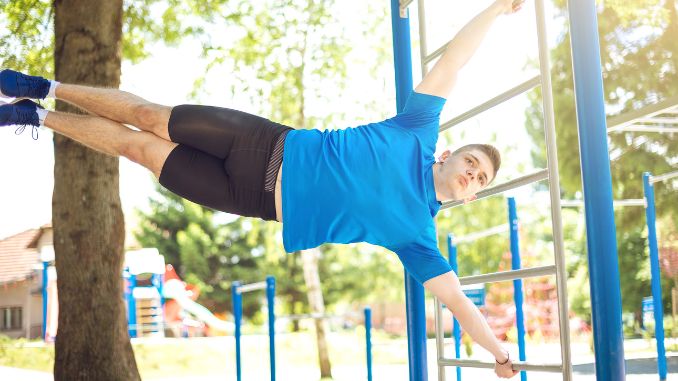This jaw-dropping move may look impossible, but with the right plan, anyone can train for it. It’s not just about strength—it’s about control, balance, and technique. Let’s break it down step by step so you can start your journey to mastering the Human Flag today.
What is the Human Flag?
The Human Flag is one of the most visually striking bodyweight feats out there. Imagine gripping a vertical pole, locking your arms, and lifting your entire body sideways—holding it parallel to the ground like a flag in the wind. It’s not just cool to look at—it’s a symbol of serious body control, power, and precision.
Why It’s So Impressive
The Human Flag demands full-body coordination and strength. You’re not just using your arms—you’re engaging your core, lats, shoulders, glutes, and even your grip to stay suspended. The ability to hold yourself in that position, even for a second or two, shows elite levels of functional strength, balance, and focus. It’s a challenge most gym-goers never even attempt—and that’s exactly why it feels so rewarding to chase.
The Functional Strength Behind It
Unlike flashy isolation movements, the flag trains and tests your body as one powerful unit. Your bottom arm must press hard (like a one-arm push-up), while your top arm pulls with serious force (like a one-arm chin-up). Your core has to lock in tight to stabilize and hold your legs steady. It’s a next-level move that builds real-world strength—strength that carries over to sports, obstacle courses, calisthenics, and even everyday activities.
How to Do the Human Flag (Step-by-Step Guide)
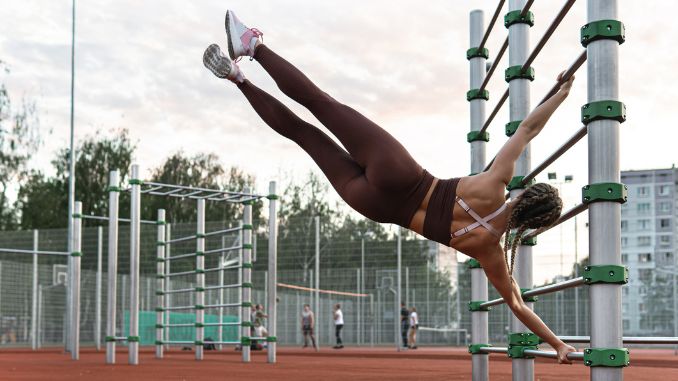
- Begin by standing next to a strong vertical pole or bar.
- Place your top hand high on the pole with your thumb pointing down, and your bottom hand low with your fingers pointing downward.
- Engage your core muscles and press firmly with your bottom arm while pulling with your top arm.
- Keep your body straight and lift your legs off the ground, aiming to hold them out to the side, parallel to the ground.
- Start with your knees bent if needed, then progress to straight legs.
- Hold this position briefly, then lower yourself back to the ground with control.
- Complete the movement for 3 sets of 3–5 attempts per side.
According to Kavadlo, the human flag requires a solid foundation and consistent training—there are no shortcuts. Aim for at least 10 strict pull-ups and 30 controlled push-ups to build the essential strength for progress.
1. Grip and Pole Setup
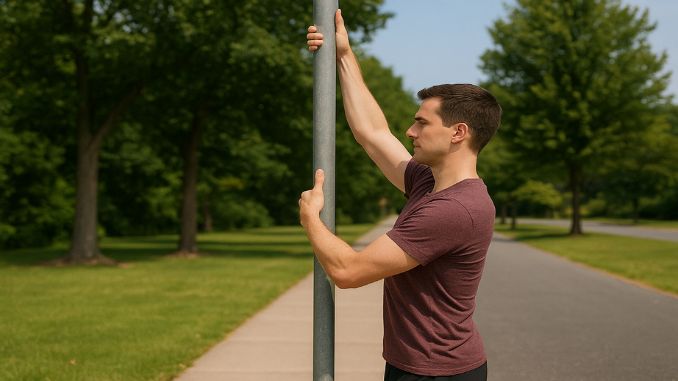
- Find a pole that allows a grip wider than shoulder-width.
- Bottom hand: Palm faces away from you with elbow locked.
- Top hand: Thumb points up while gripping firmly.
- Stack your shoulders vertically and engage your scapula by pulling them together.
- Outdoor poles, like stop signs or bus stop posts, are ideal if gym setups are limited.
2. Leg Positioning

- Start with tucked knees to shorten the lever and make it easier to control.
- Progress to straight-leg holds as your strength and control improve.
3. Arm Mechanics
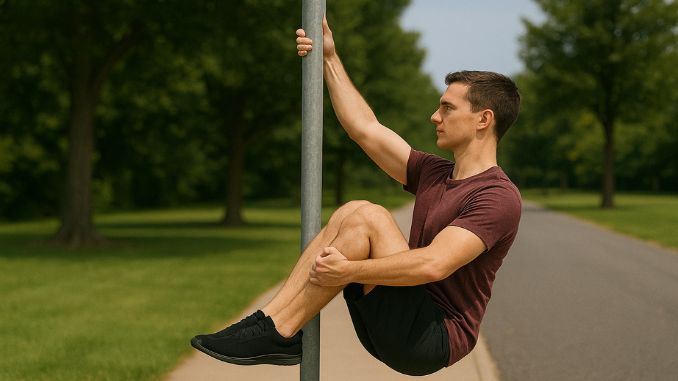
- Bottom Arm: Provides pressing strength—requires strong triceps and locked elbow positioning.
- Top Arm: Does the pulling—engages biceps and lats to lift and stabilize.
Prevent Injuries
Shawna experienced elbow pain (tennis elbow) from overuse in the early stages. Prevent injury with the following strategies:
- Limit daily attempts and avoid excessive volume.
- Use a foam roller on the forearms and around the elbow.
- Never hyperextend or overload the elbow during practice.
- Prioritize recovery time between training sessions.
Common Mistakes
- Rotating the chest downward (not facing sideways)
- Bending arms instead of keeping them locked
- Overarching the back (poor body alignment [1])
Helpful Exercises for the Human Flag
1. Hanging Leg Raise
- Begin by standing on a sturdy platform and gripping an overhead bar with both hands, keeping your arms fully extended. Let your body hang naturally with your legs together.
- Engage your core and slowly raise both legs in front of you.
- Focus on curling your pelvis upward toward your ribs rather than just lifting your knees.
- Pause briefly at the top, then lower your legs back down with control.
- Return to the starting position. Repeat the movement for 3 sets of 5 repetitions.

2. Hanging Oblique Lift
- Begin by standing on a stable platform and gripping an overhead bar with both hands, keeping your arms straight and your feet off the floor.
- Engage your core and slowly lift both knees toward one side of your body, aiming to bring them toward your elbow.
- Pause briefly at the top, feeling the twist in your waist.
- Lower your legs back down with control.
- Return to the starting position and repeat the movement on the opposite side.
- Complete the exercise for 3 sets of 5 repetitions on each side.
3. Barbell Windshield Wiper

- Begin by lying on your back with your legs bent and feet off the floor.
- Hold a barbell with both hands directly above your chest, keeping your arms straight. Engage your core and lift your knees toward your chest.
- Slowly rotate your legs to one side, keeping your shoulders flat and the barbell steady.
- Pause briefly, then bring your legs back to the center.
- Lower your legs to the opposite side and return to the middle again. Keep the motion smooth and controlled.
- Complete the movement for 3 sets of 5 repetitions on each side.
4. Hanging Windshield Wiper
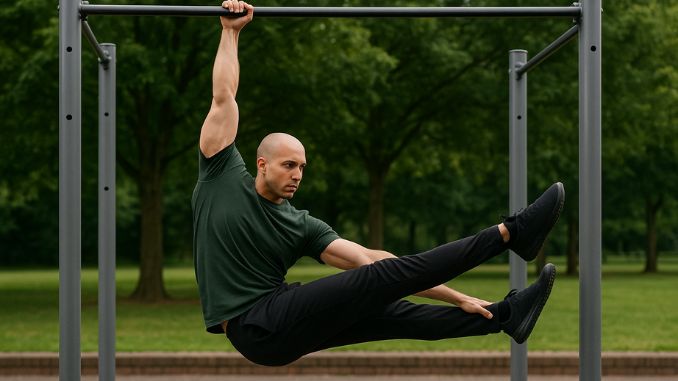
- Begin by hanging from an overhead bar with both hands, arms straight, and feet off the floor.
- Engage your core and lift your legs until they are parallel to the ground.
- Keeping your core tight, slowly rotate your legs to one side while maintaining control and avoiding swinging.
- Return to the center, then rotate to the other side.
- Repeat for 3 sets of 5 repetitions per side.
Benefits of the Human Flag
- Full-body strength (shoulders, core, arms, back, glutes)
- Improves shoulder stability [2] and joint control
- Boosts core strength and body tension
- Enhances balance & coordination
- Builds mental toughness through advanced training
- Looks impressive – superhero-level body control
Final Thoughts
The Human Flag is more than just an impressive display of strength. It represents discipline, control, and the ability to push past limits. Each step toward mastering it builds not only physical power but confidence and mental resilience.
You don’t need to be an elite athlete to start. With the right progressions and consistency, anyone can begin this journey. Start with one simple drill today. The hardest part is often just showing up.
Are YOU one of the few who can master the Human Flag? Start the journey now. And if you’re ready for the next step, our Tone and Tighten Arm Workout will give you the strength advantage you need.
Frequently Asked Questions
Is the human flag difficult?
Yes, the human flag is difficult because it requires exceptional upper-body strength and serious core strength. You’re holding your entire body weight sideways, which means your shoulders, arms, and midsection have to work together in perfect coordination. Most people need to follow a structured human flag training plan that includes progressions like half lay and one-leg versions before they can achieve the full human flag.
How to be a human flag?
To become a human flag, you need to train progressively. Start by building core strength andexceptional upper body strength, focusing on exercises like pull-ups, side planks, and leg raises. Your human flag training should include static holds like the half lay (where legs are bent) and one-leg variations to gradually increase control and strength. With time, you’ll be able to extend both legs for the full human flag hold.
What is the longest human flag hold?
While there’s no officially recognized world record by a global body, some elite athletes have held the full human flag for over 1 minute, though most average practitioners aim for 5 to 10 seconds at first. Holding the flag that long takes years of human flag training, especially to develop the exceptional upper body strength and core strength required to stabilize your body in the air.
What muscles do human flags work?
The human flag is a full-body movement but mainly targets the core muscles, especially the obliques and deep stabilizers. It also works the lats, shoulders, biceps, and triceps. Holding any version—one leg, half lay, or the full human flag—demands coordinated effort from your entire upper body, including grip and scapular strength. That’s why proper human flag training always includes both push and pull exercises, along with focused core strength work.

